On the Sustainable Choice of Alloying Elements for Strength of Aluminum-Based Alloys
Abstract
1. Introduction
2. Methodology
2.1. Alloying Element Strength Contribution
2.2. Environmental Alloying Efficiency Index for Alloying Elements
2.3. Environmental Alloying Efficiency Index with Alloying Element Cost Weighting
3. Results and Discussion
3.1. Alloying Element Strength Contribution
3.2. Environmental Load From Alloying Elements
3.3. Environmental Alloying Efficiency Index for Alloying Elements
3.4. Environmental Alloying Efficiency Index with Alloying Element Cost Weighting
4. Conclusions
Author Contributions
Funding
Acknowledgments
Conflicts of Interest
Appendix A
| Alloy | Si | Fe | Cu | Mn | Mg | Cr | Ni | Zn | Ti | Be | Sn | Ce | La | Y | Er | Al | UTS MPa | Ref |
|---|---|---|---|---|---|---|---|---|---|---|---|---|---|---|---|---|---|---|
| 1145 | 0 | 0 | 0 | 0 | 0 | 0 | 0 | 0 | 0 | 0 | 0 | 0 | 0 | 0 | 0 | 100 | 89.6 | [14] |
| 1350 | 0 | 0 | 0 | 0 | 0 | 0 | 0 | 0 | 0 | 0 | 0 | 0 | 0 | 0 | 0 | 100 | 82.7 | [14] |
| 2017 | 0.5 | 0 | 4 | 0.7 | 0.6 | 0 | 0 | 0 | 0 | 0 | 0 | 0 | 0 | 0 | 0 | 94.2 | 180 | [14] |
| 2024 | 0 | 0 | 4.4 | 0.6 | 1.5 | 0 | 0 | 0 | 0 | 0 | 0 | 0 | 0 | 0 | 0 | 93.5 | 185 | [14] |
| 2024 | 0 | 0 | 4.4 | 0.6 | 1.5 | 0 | 0 | 0 | 0 | 0 | 0 | 0 | 0 | 0 | 0 | 93.5 | 180 | [14] |
| 2219 | 0 | 0 | 6.3 | 0.3 | 0 | 0 | 0 | 0 | 0.06 | 0 | 0 | 0 | 0 | 0 | 0 | 93.34 | 170 | [14] |
| 3002 | 0 | 0 | 0 | 0.15 | 0.12 | 0 | 0 | 0 | 0 | 0 | 0 | 0 | 0 | 0 | 0 | 99.73 | 90 | [14] |
| 3003 | 0 | 0 | 0.12 | 1.2 | 0 | 0 | 0 | 0 | 0 | 0 | 0 | 0 | 0 | 0 | 0 | 98.68 | 110 | [14] |
| 3003 | 0 | 0 | 0.12 | 1.2 | 0 | 0 | 0 | 0 | 0 | 0 | 0 | 0 | 0 | 0 | 0 | 98.68 | 110 | [14] |
| 3004 | 0 | 0 | 0 | 1.2 | 1 | 0 | 0 | 0 | 0 | 0 | 0 | 0 | 0 | 0 | 0 | 97.8 | 180 | [14] |
| 3004 | 0 | 0 | 0 | 1.2 | 1 | 0 | 0 | 0 | 0 | 0 | 0 | 0 | 0 | 0 | 0 | 97.8 | 180 | [14] |
| 3005 | 0 | 0 | 0 | 1.2 | 0.4 | 0 | 0 | 0 | 0 | 0 | 0 | 0 | 0 | 0 | 0 | 98.4 | 130 | [14] |
| 3102 | 0 | 0 | 0 | 0.22 | 0 | 0 | 0 | 0 | 0 | 0 | 0 | 0 | 0 | 0 | 0 | 99.78 | 95 | [14] |
| 3105 | 0 | 0 | 0 | 0.6 | 0.5 | 0 | 0 | 0 | 0 | 0 | 0 | 0 | 0 | 0 | 0 | 98.9 | 115 | [14] |
| 5005 | 0 | 0 | 0 | 0 | 0.8 | 0 | 0 | 0 | 0 | 0 | 0 | 0 | 0 | 0 | 0 | 99.2 | 125 | [14] |
| 5010 | 0 | 0 | 0 | 0 | 0 | 0 | 0 | 0 | 0 | 0 | 0 | 0 | 0 | 0 | 0 | 100 | 115 | [14] |
| 5042 | 0 | 0 | 0 | 0.35 | 3.5 | 0 | 0 | 0 | 0 | 0 | 0 | 0 | 0 | 0 | 0 | 96.15 | 230 | [14] |
| 5050 | 0 | 0 | 0 | 0 | 1.4 | 0 | 0 | 0 | 0 | 0 | 0 | 0 | 0 | 0 | 0 | 98.6 | 145 | [14] |
| 5051 | 0 | 0 | 0 | 0 | 2 | 0 | 0 | 0 | 0 | 0 | 0 | 0 | 0 | 0 | 0 | 98 | 165 | [14] |
| 5052 | 0 | 0 | 0 | 0 | 2.5 | 0.25 | 0 | 0 | 0 | 0 | 0 | 0 | 0 | 0 | 0 | 97.25 | 195 | [14] |
| 5056 | 0 | 0 | 0 | 0.12 | 5 | 0.12 | 0 | 0 | 0 | 0 | 0 | 0 | 0 | 0 | 0 | 94.76 | 290 | [14] |
| 5059 | 0 | 0 | 0 | 0.9 | 5.5 | 0 | 0 | 0.62 | 0 | 0 | 0 | 0 | 0 | 0 | 0 | 92.98 | 360 | [14] |
| 5083 | 0 | 0 | 0 | 0.7 | 4.4 | 0.15 | 0 | 0 | 0 | 0 | 0 | 0 | 0 | 0 | 0 | 94.75 | 290 | [14] |
| 5086 | 0 | 0 | 0 | 0.45 | 4 | 0.15 | 0 | 0 | 0 | 0 | 0 | 0 | 0 | 0 | 0 | 95.4 | 260 | [14] |
| 5154 | 0 | 0 | 0 | 0 | 3.5 | 0.25 | 0 | 0 | 0 | 0 | 0 | 0 | 0 | 0 | 0 | 96.25 | 240 | [14] |
| 5182 | 0 | 0 | 0 | 0.35 | 4.5 | 0 | 0 | 0 | 0 | 0 | 0 | 0 | 0 | 0 | 0 | 95.15 | 275 | [14] |
| 5254 | 0 | 0 | 0 | 0 | 3.5 | 0.25 | 0 | 0 | 0 | 0 | 0 | 0 | 0 | 0 | 0 | 96.25 | 230 | [14] |
| 5383 | 0 | 0 | 0 | 0.85 | 4.75 | 0 | 0 | 0 | 0 | 0 | 0 | 0 | 0 | 0 | 0 | 94.4 | 315 | [14] |
| 5454 | 0 | 0 | 0 | 0.8 | 2.7 | 0.12 | 0 | 0 | 0 | 0 | 0 | 0 | 0 | 0 | 0 | 96.38 | 250 | [14] |
| 5456 | 0 | 0 | 0 | 0.8 | 5.1 | 0.12 | 0 | 0 | 0 | 0 | 0 | 0 | 0 | 0 | 0 | 93.98 | 310 | [14] |
| 5457 | 0 | 0 | 0 | 0.3 | 1 | 0 | 0 | 0 | 0 | 0 | 0 | 0 | 0 | 0 | 0 | 98.7 | 220 | [14] |
| 6061 | 0.6 | 0 | 0.28 | 0 | 1 | 0.2 | 0 | 0 | 0 | 0 | 0 | 0 | 0 | 0 | 0 | 97.92 | 125 | [14] |
| 6061 | 0.6 | 0 | 0.28 | 0 | 1 | 0.2 | 0 | 0 | 0 | 0 | 0 | 0 | 0 | 0 | 0 | 97.92 | 115 | [14] |
| 6063 | 0.4 | 0 | 0 | 0 | 0.7 | 0 | 0 | 0 | 0 | 0 | 0 | 0 | 0 | 0 | 0 | 98.9 | 90 | [14] |
| 6066 | 1.4 | 0 | 1 | 0.8 | 1.1 | 0 | 0 | 0 | 0 | 0 | 0 | 0 | 0 | 0 | 0 | 95.7 | 150 | [14] |
| 7075 | 0 | 0 | 1.6 | 0 | 2.5 | 0.23 | 0 | 5.6 | 0 | 0 | 0 | 0 | 0 | 0 | 0 | 90.07 | 220 | [14] |
| 7178 | 0 | 0 | 2 | 0 | 2.8 | 0.23 | 0 | 6.8 | 0 | 0 | 0 | 0 | 0 | 0 | 0 | 88.17 | 230 | [14] |
| 7178 | 0 | 0 | 2 | 0 | 2.8 | 0.23 | 0 | 6.8 | 0 | 0 | 0 | 0 | 0 | 0 | 0 | 88.17 | 220 | [14] |
| 208.0 | 3 | 0 | 4 | 0 | 0 | 0 | 0 | 0 | 0 | 0 | 0 | 0 | 0 | 0 | 0 | 93 | 245 | [14] |
| 222.0 | 0 | 0 | 10 | 0 | 0.25 | 0 | 0 | 0 | 0 | 0 | 0 | 0 | 0 | 0 | 0 | 89.75 | 185 | [14] |
| 230 | 4 | 1.5 | 10 | 0.6 | 0.25 | 0 | 1 | 1.5 | 0.25 | 0 | 0 | 0 | 0 | 0 | 0 | 80.9 | 205 | [14] |
| 240 | 0 | 0 | 8 | 0.5 | 6 | 0 | 0.5 | 0 | 0 | 0 | 0 | 0 | 0 | 0 | 0 | 85 | 235 | [14] |
| 242 | 0 | 0 | 4 | 0 | 1.5 | 0 | 2 | 0 | 0 | 0 | 0 | 0 | 0 | 0 | 0 | 92.5 | 145 | [14] |
| A242.0 | 0 | 0 | 4.1 | 0 | 1.4 | 0.2 | 2 | 0 | 0.14 | 0 | 0 | 0 | 0 | 0 | 0 | 92.16 | 185 | [14] |
| 295 | 1.1 | 0 | 4.5 | 0 | 0 | 0 | 0 | 0 | 0 | 0 | 0 | 0 | 0 | 0 | 0 | 94.4 | 170 | [14] |
| 308 | 5.5 | 0 | 4.5 | 0 | 0 | 0 | 0 | 0 | 0 | 0 | 0 | 0 | 0 | 0 | 0 | 90 | 195 | [14] |
| 319 | 6 | 0 | 3.5 | 0 | 0 | 0 | 0 | 0 | 0 | 0 | 0 | 0 | 0 | 0 | 0 | 90.5 | 185 | [14] |
| 319 | 6 | 0 | 3.5 | 0 | 0 | 0 | 0 | 0 | 0 | 0 | 0 | 0 | 0 | 0 | 0 | 90.5 | 235 | [14] |
| 328.0 | 8 | 0 | 1.5 | 0.4 | 0.4 | 0 | 0 | 0 | 0 | 0 | 0 | 0 | 0 | 0 | 0 | 89.7 | 170 | [14] |
| 333 | 9 | 0 | 3.5 | 0 | 0.28 | 0 | 0 | 0 | 0 | 0 | 0 | 0 | 0 | 0 | 0 | 87.22 | 235 | [14] |
| 355 | 5 | 0 | 1.25 | 0 | 0.5 | 0 | 0 | 0 | 0 | 0 | 0 | 0 | 0 | 0 | 0 | 93.25 | 160 | [14] |
| C355.0 | 5 | 0 | 1.25 | 0 | 0.5 | 0 | 0 | 0 | 0 | 0 | 0 | 0 | 0 | 0 | 0 | 93.25 | 185 | [14] |
| 356 | 7 | 0 | 0 | 0 | 0.32 | 0 | 0 | 0 | 0 | 0 | 0 | 0 | 0 | 0 | 0 | 92.68 | 165 | [14] |
| 356 | 7 | 0 | 0 | 0 | 0.32 | 0 | 0 | 0 | 0 | 0 | 0 | 0 | 0 | 0 | 0 | 92.68 | 180 | [14] |
| A356.0 | 7 | 0 | 0 | 0 | 0.35 | 0 | 0 | 0 | 0 | 0 | 0 | 0 | 0 | 0 | 0 | 92.65 | 160 | [14] |
| A356.0 | 7 | 0 | 0 | 0 | 0.35 | 0 | 0 | 0 | 0 | 0 | 0 | 0 | 0 | 0 | 0 | 92.65 | 185 | [14] |
| 357 | 7 | 0 | 0 | 0 | 0.52 | 0 | 0 | 0 | 0 | 0 | 0 | 0 | 0 | 0 | 0 | 92.48 | 170 | [14] |
| A357.0 | 7 | 0 | 0 | 0 | 0.55 | 0 | 0 | 0 | 0.12 | 0.055 | 0 | 0 | 0 | 0 | 0 | 92.275 | 195 | [14] |
| 360 | 9.5 | 0 | 0 | 0 | 0.5 | 0 | 0 | 0 | 0 | 0 | 0 | 0 | 0 | 0 | 0 | 90 | 305 | [14] |
| A360.0 | 9.5 | 0 | 0 | 0 | 0.5 | 0 | 0 | 0 | 0 | 0 | 0 | 0 | 0 | 0 | 0 | 90 | 315 | [14] |
| 380 | 8.5 | 0 | 3.5 | 0 | 0 | 0 | 0 | 0 | 0 | 0 | 0 | 0 | 0 | 0 | 0 | 88 | 315 | [14] |
| A380.0 | 8.5 | 0 | 3.5 | 0 | 0 | 0 | 0 | 0 | 0 | 0 | 0 | 0 | 0 | 0 | 0 | 88 | 325 | [14] |
| 383 | 10.5 | 0 | 2.5 | 0 | 0 | 0 | 0 | 0 | 0 | 0 | 0 | 0 | 0 | 0 | 0 | 87 | 310 | [14] |
| 384 | 11.2 | 0 | 3.8 | 0 | 0 | 0 | 0 | 0 | 0 | 0 | 0 | 0 | 0 | 0 | 0 | 85 | 330 | [14] |
| B390.0 | 17 | 0 | 4.5 | 0 | 0.55 | 0 | 0 | 0 | 0 | 0 | 0 | 0 | 0 | 0 | 0 | 77.95 | 315 | [14] |
| 413 | 12 | 0 | 0 | 0 | 0 | 0 | 0 | 0 | 0 | 0 | 0 | 0 | 0 | 0 | 0 | 88 | 295 | [14] |
| A413.0 | 12 | 0 | 0 | 0 | 0 | 0 | 0 | 0 | 0 | 0 | 0 | 0 | 0 | 0 | 0 | 88 | 290 | [14] |
| 443 | 5.2 | 0 | 0 | 0 | 0 | 0 | 0 | 0 | 0 | 0 | 0 | 0 | 0 | 0 | 0 | 94.8 | 130 | [14] |
| B443.0 | 5.2 | 0 | 0 | 0 | 0 | 0 | 0 | 0 | 0 | 0 | 0 | 0 | 0 | 0 | 0 | 94.8 | 160 | [14] |
| C443.0 | 5.2 | 0 | 0 | 0 | 0 | 0 | 0 | 0 | 0 | 0 | 0 | 0 | 0 | 0 | 0 | 94.8 | 115 | [14] |
| A444.0 | 7 | 0 | 0 | 0 | 0 | 0 | 0 | 0 | 0 | 0 | 0 | 0 | 0 | 0 | 0 | 93 | 145 | [14] |
| A444.0 | 7 | 0 | 0 | 0 | 0 | 0 | 0 | 0 | 0 | 0 | 0 | 0 | 0 | 0 | 0 | 93 | 165 | [14] |
| 512 | 1.8 | 0 | 0 | 0 | 4 | 0 | 0 | 0 | 0 | 0 | 0 | 0 | 0 | 0 | 0 | 94.2 | 140 | [14] |
| 513 | 0 | 0 | 0 | 0 | 4 | 0 | 0 | 1.8 | 0 | 0 | 0 | 0 | 0 | 0 | 0 | 94.2 | 185 | [14] |
| 514 | 0 | 0 | 0 | 0 | 4 | 0 | 0 | 0 | 0 | 0 | 0 | 0 | 0 | 0 | 0 | 96 | 170 | [14] |
| 518 | 0 | 0 | 0 | 0 | 8 | 0 | 0 | 0 | 0 | 0 | 0 | 0 | 0 | 0 | 0 | 92 | 310 | [14] |
| 535 | 0 | 0 | 0 | 0.18 | 6.8 | 0 | 0 | 0 | 0.18 | 0.005 | 0 | 0 | 0 | 0 | 0 | 92.835 | 240 | [14] |
| 535 | 0 | 0 | 0 | 0.18 | 6.8 | 0 | 0 | 0 | 0.18 | 0.005 | 0 | 0 | 0 | 0 | 0 | 92.835 | 240 | [14] |
| 710 | 0 | 0 | 0.5 | 0 | 0.7 | 0 | 0 | 6.5 | 0 | 0 | 0 | 0 | 0 | 0 | 0 | 92.3 | 220 | [14] |
| 711 | 0 | 1 | 0.5 | 0 | 0.35 | 0 | 0 | 6.5 | 0 | 0 | 0 | 0 | 0 | 0 | 0 | 91.65 | 195 | [14] |
| 712 | 0 | 0 | 0 | 0 | 0.58 | 0.5 | 0 | 6 | 0.2 | 0 | 0 | 0 | 0 | 0 | 0 | 92.72 | 235 | [14] |
| 713 | 0 | 0 | 0.7 | 0 | 0.35 | 0 | 0 | 7.5 | 0 | 0 | 0 | 0 | 0 | 0 | 0 | 91.45 | 220 | [14] |
| Exp. | 0 | 0.16 | 0 | 0 | 3 | 0 | 0 | 0 | 0 | 0 | 0 | 0 | 0 | 0 | 0 | 96.84 | 184 | [13] |
| Exp. | 0 | 0.16 | 0 | 0 | 3 | 0 | 0 | 0 | 0 | 0 | 0 | 0.1 | 0 | 0 | 0 | 96.74 | 202 | [13] |
| Exp. | 0 | 0.16 | 0 | 0 | 3 | 0 | 0 | 0 | 0 | 0 | 0 | 0.2 | 0 | 0 | 0 | 96.64 | 203 | [13] |
| Exp. | 0 | 0.16 | 0 | 0 | 3 | 0 | 0 | 0 | 0 | 0 | 0 | 0.3 | 0 | 0 | 0 | 96.54 | 218 | [13] |
| Exp. | 0 | 0.16 | 0 | 0 | 3 | 0 | 0 | 0 | 0 | 0 | 0 | 0.4 | 0 | 0 | 0 | 96.44 | 210 | [13] |
| Exp. | 0 | 0.16 | 0 | 0 | 3 | 0 | 0 | 0 | 0 | 0 | 0 | 0.5 | 0 | 0 | 0 | 96.34 | 200 | [13] |
| Exp. | 10.86 | 0.57 | 2.95 | 0 | 0.23 | 0 | 0 | 0.68 | 0 | 0 | 0 | 0 | 0 | 0 | 0 | 84.71 | 160 | [15] |
| Exp. | 10.53 | 0.66 | 3.36 | 0 | 0.29 | 0 | 0 | 0.54 | 0 | 0 | 0 | 0 | 0 | 0.12 | 0 | 84.5 | 220 | [15] |
| Exp. | 10.28 | 0.54 | 3.03 | 0 | 0.35 | 0 | 0 | 0.56 | 0 | 0 | 0 | 0 | 0 | 0.23 | 0 | 85.01 | 240 | [15] |
| Exp. | 10.59 | 0.66 | 3.29 | 0 | 0.3 | 0 | 0 | 0.63 | 0 | 0 | 0 | 0 | 0 | 0.34 | 0 | 84.19 | 230 | [15] |
| Exp. | 7.02 | 0.12 | 0.005 | 0.005 | 0.42 | 0 | 0 | 0 | 0.01 | 0 | 0 | 0 | 0 | 0 | 0 | 92.42 | 148 | [16] |
| Exp. | 7.02 | 0.12 | 0.005 | 0.005 | 0.42 | 0 | 0 | 0 | 0.01 | 0 | 0 | 0 | 0 | 0 | 0.2 | 92.22 | 158 | [16] |
| Exp. | 7.02 | 0.12 | 0.005 | 0.005 | 0.42 | 0 | 0 | 0 | 0.01 | 0 | 0 | 0 | 0 | 0 | 0.14 | 92.28 | 169 | [16] |
| Exp. | 7.02 | 0.12 | 0.005 | 0.005 | 0.42 | 0 | 0 | 0 | 0.01 | 0 | 0 | 0 | 0 | 0 | 0.5 | 91.92 | 167 | [16] |
| Exp. | 7.02 | 0.12 | 0.005 | 0.005 | 0.42 | 0 | 0 | 0 | 0.01 | 0 | 0 | 0 | 0 | 0 | 0.6 | 91.82 | 155 | [16] |
| Exp. | 7.02 | 0.12 | 0.005 | 0.005 | 0.42 | 0 | 0 | 0 | 0.01 | 0 | 0 | 0 | 0 | 0 | 0.7 | 91.72 | 154 | [16] |
| Exp. | 7.2 | 0.09 | 0.01 | 0.01 | 0.49 | 0 | 0 | 0.01 | 0 | 0 | 0 | 0 | 0 | 0 | 0 | 92.19 | 230 | [17] |
| Exp. | 7.2 | 0.09 | 0.01 | 0.01 | 0.49 | 0 | 0 | 0.01 | 0 | 0 | 0 | 0 | 0.01 | 0 | 0 | 92.18 | 255 | [17] |
| Exp. | 7.2 | 0.09 | 0.01 | 0.01 | 0.49 | 0 | 0 | 0.01 | 0 | 0 | 0 | 0 | 0.03 | 0 | 0 | 92.16 | 242 | [17] |
| Exp. | 7.2 | 0.09 | 0.01 | 0.01 | 0.49 | 0 | 0 | 0.01 | 0 | 0 | 0 | 0 | 0.05 | 0 | 0 | 92.14 | 249 | [17] |
| Exp. | 7.2 | 0.09 | 0.01 | 0.01 | 0.49 | 0 | 0 | 0.01 | 0 | 0 | 0 | 0 | 0.07 | 0 | 0 | 92.12 | 249 | [17] |
| Exp. | 7.2 | 0.09 | 0.01 | 0.01 | 0.49 | 0 | 0 | 0.01 | 0 | 0 | 0 | 0 | 0.1 | 0 | 0 | 92.09 | 273 | [17] |
| Exp. | 7.2 | 0.09 | 0.01 | 0.01 | 0.49 | 0 | 0 | 0.01 | 0 | 0 | 0 | 0 | 0.3 | 0 | 0 | 91.89 | 272 | [17] |
| Exp. | 7.2 | 0.09 | 0.01 | 0.01 | 0.49 | 0 | 0 | 0.01 | 0 | 0 | 0 | 0 | 0.5 | 0 | 0 | 91.69 | 273 | [17] |
| Exp. | 7.2 | 0.09 | 0.01 | 0.01 | 0.49 | 0 | 0 | 0.01 | 0 | 0 | 0 | 0 | 1 | 0 | 0 | 91.19 | 230 | [17] |
| Exp. | 11 | 0.4 | 1.5 | 0 | 0.3 | 0 | 0 | 0 | 0 | 0 | 0 | 0 | 0 | 0 | 0 | 86.8 | 240 | [18] |
| Exp. | 11 | 0.4 | 1.5 | 0 | 0.3 | 0 | 0 | 0 | 0 | 0 | 0 | 0 | 0.5 | 0 | 0 | 86.3 | 245 | [18] |
| Exp. | 11 | 0.4 | 1.5 | 0 | 0.3 | 0 | 0 | 0 | 0 | 0 | 0 | 0 | 0.1 | 0 | 0 | 86.7 | 260 | [18] |
| Exp. | 11 | 0.4 | 1.5 | 0 | 0.3 | 0 | 0 | 0 | 0 | 0 | 0 | 0 | 0.2 | 0 | 0 | 86.6 | 250 | [18] |
| Exp. | 0.65 | 0.13 | 0.27 | 0 | 0.95 | 0.15 | 0 | 0 | 0 | 0 | 2 | 0 | 0 | 0 | 0 | 95.85 | 157 | [18] |
References
- Kenworthy, J.R. Transport Energy Use and Greenhouse Gases in Urban Passenger Transport Systems: A Study of 84 Global Cities. In Proceedings of the International Sustainability Conference, Fremantle, Western Australia, 17–19 September 2003; pp. 1–28. [Google Scholar]
- Hooftman, N.; Messagie, M.; Van Mierlo, J.; Coosemans, T. A review of the European passenger car regulations–Real driving emissions vs local air quality. Renew. Sustain. Energy Rev. 2018, 86, 1–21. [Google Scholar] [CrossRef]
- Serrenho, A.C.; Norman, J.B.; Allwood, J.M. The impact of reducing car weight on global emissions: The future fleet in Great Britain. Philos. Trans. A. Math. Phys. Eng. Sci. 2017, 375, 20160364. [Google Scholar] [CrossRef] [PubMed]
- Jarfors, A.E.W.; Kainer, K.-U.; Tan, M.-J.; Yong, J. Recent developments in the manufactruing of components from Aluminum-, Magnesium- and Titanium-based alloys. Cosmos 2009, 5, 23–58. [Google Scholar] [CrossRef]
- Jarfors, A.; Bejhem, M.; Carlsson, T.; Eliasson, A.; Keife, H.; Nicolescu, C.-M. Tillverkningsteknologi; 4 (2010); Studentlitteratur: Lund, Sweden, 1999; 637p. [Google Scholar]
- Dieter, G.E. Mechanical Metallurgy; McGraw-Hill Book Company: New York, NY, USA, 1961. [Google Scholar]
- Ceschini, L.; Dahle, A.; Gupta, M.; Wollmar, A.E.; Jayalakshmi, J.S.; Morri, A.; Rotundo, F.; Toschi, S.; Singh, R.A. Engineering Materials Aluminum and Magnesium Metal Matrix Nanocomposites; Springer Nature: Singapore, 2017; p. 171. [Google Scholar]
- CES EduPack 2019, Version 19.2.0, Software; Granta Design Limited: Cambridge, UK, 2019.
- Charney, J.G.; Arakawa, A.; Baker, D.J.; Bolin, B.; Dickinson, R.E.; Goody, R.M.; Leith, C.E.; Stommel, H.M.; Wunsch, C.I. Carbon Dioxide and Climate: A Scientific Assessment; National Academy of Sciences: Washington, DC, USA, 1979. [Google Scholar]
- Casarotto, F.; Franke, A.J.; Franke, R. High-Pressure Die-Cast (HPDC) Aluminum Alloys for Automotive Applications; Woodhead Publishing: Sawston, Cambridge, UK, 2012. [Google Scholar]
- Nee, A.Y.C. Handbook of Manufacturing Engineering and Technology; Springer Nature: London, UK, 2015. [Google Scholar]
- Nonferrous Metals. Available online: https://www.ccmn.cn/priceinfo/ (accessed on 16 September 2019).
- Zhang, X.; Wang, Z.; Zhou, Z.; Xu, J. Influence of rare earth (Ce and La) addition on the performance of Al-3.0 wt%Mg alloy. J. Wuhan Univ. Technol. - Mater. Sci. Ed. 2017, 32, 611–618. [Google Scholar] [CrossRef]
- Anderson, K.; Weiritz, J.; Kaufman, J.G. Properties and Selection of Aluminum Alloys; ASM International: Novelty, OH, USA, 2019. [Google Scholar]
- Liu, J.; Wu, Q.; Yan, H.; Zhong, S.; Huang, Z. Effect of trace yttrium addition and heat treatment on the microstructure and mechanical properties of as-cast ADC12 aluminum alloy. Appl. Sci. 2018, 9, 53. [Google Scholar] [CrossRef]
- Li, X.-Y.; Lu, Y.-L.; Wang, J.; Zhou, D.; Yang, L. Effect of Rare Earth Erbium on Microstructure and Mechanical Properties of A356 Aluminum Alloy. J. Mater. Eng. 2018, 46, 67–73. [Google Scholar]
- Pourbahari, B.; Emamy, M. Effects of La intermetallics on the structure and tensile properties of thin section gravity die-cast A357 Al alloy. Mater. Des. 2016, 94, 111–120. [Google Scholar] [CrossRef]
- Lu, T.; Pan, Y.; Wu, J.-L.; Tao, S.-W.; Chen, Y. Effects of La addition on the microstructure and tensile properties of Al-Si-Cu-Mg casting alloys. Int. J. Miner. Metall. Mater. 2015, 22, 405–410. [Google Scholar] [CrossRef]
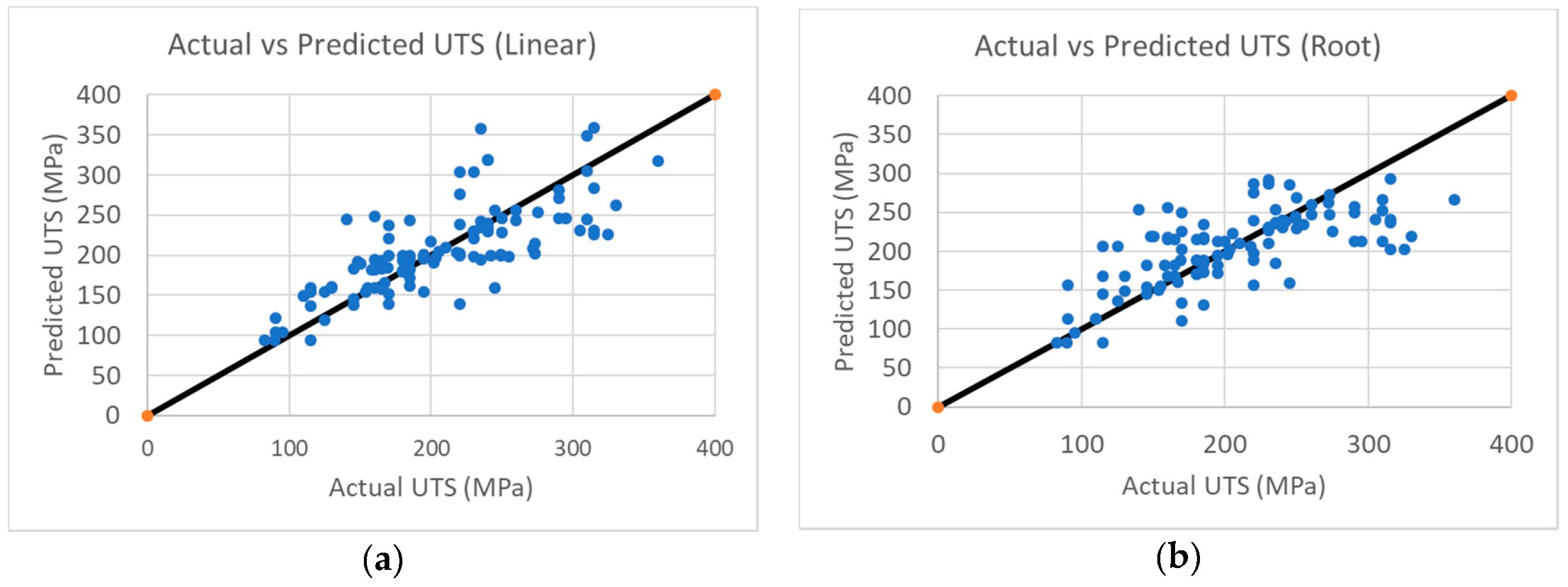
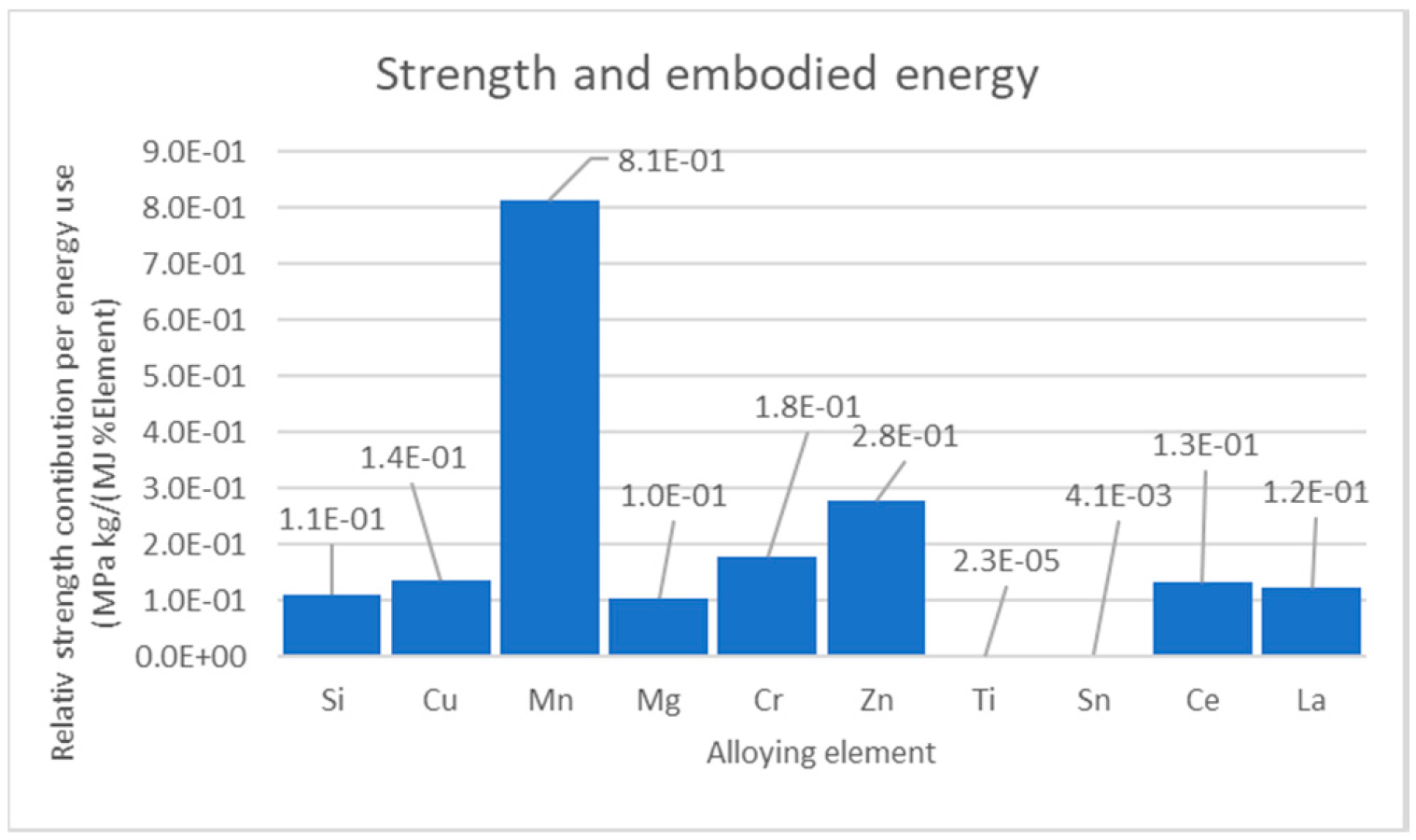
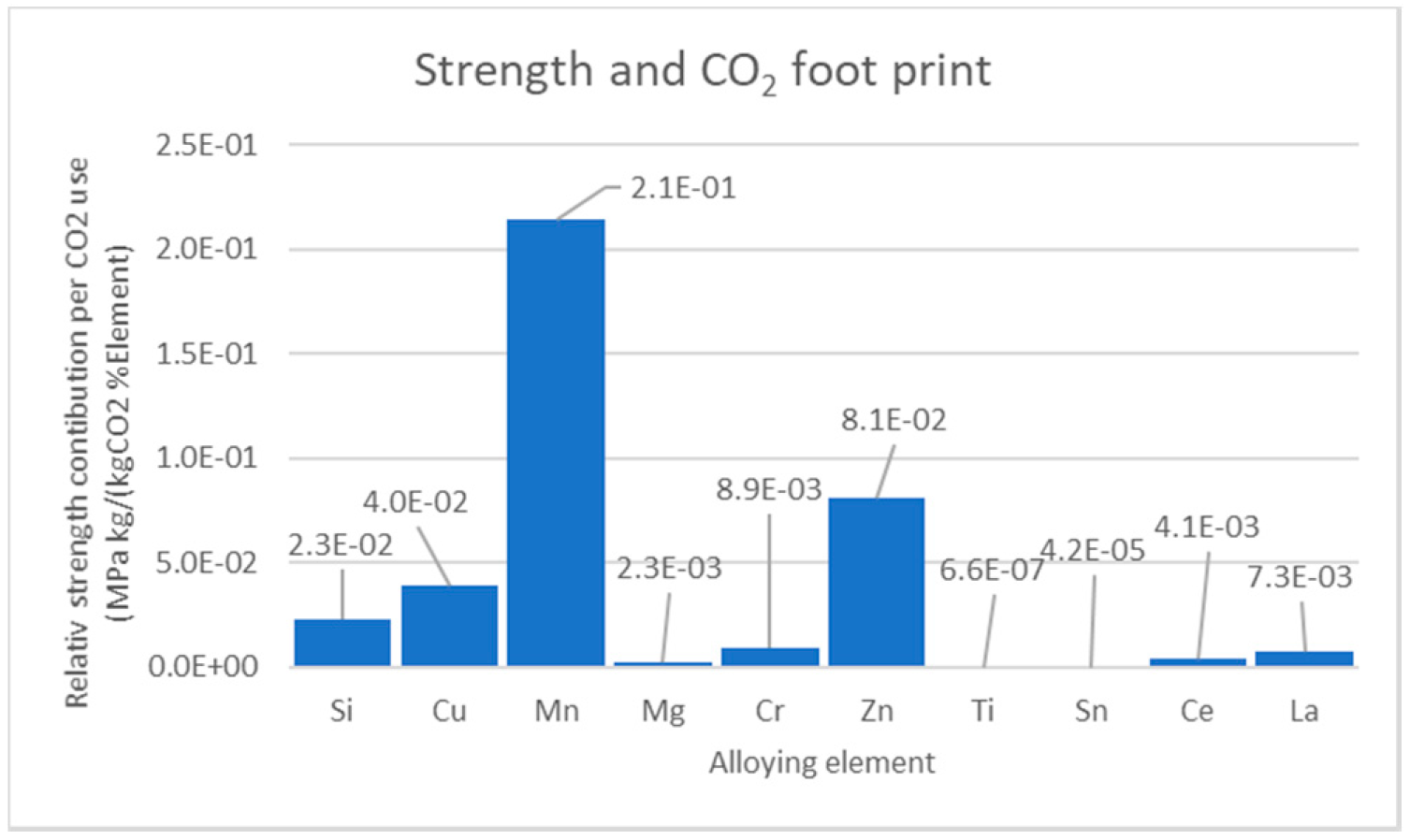
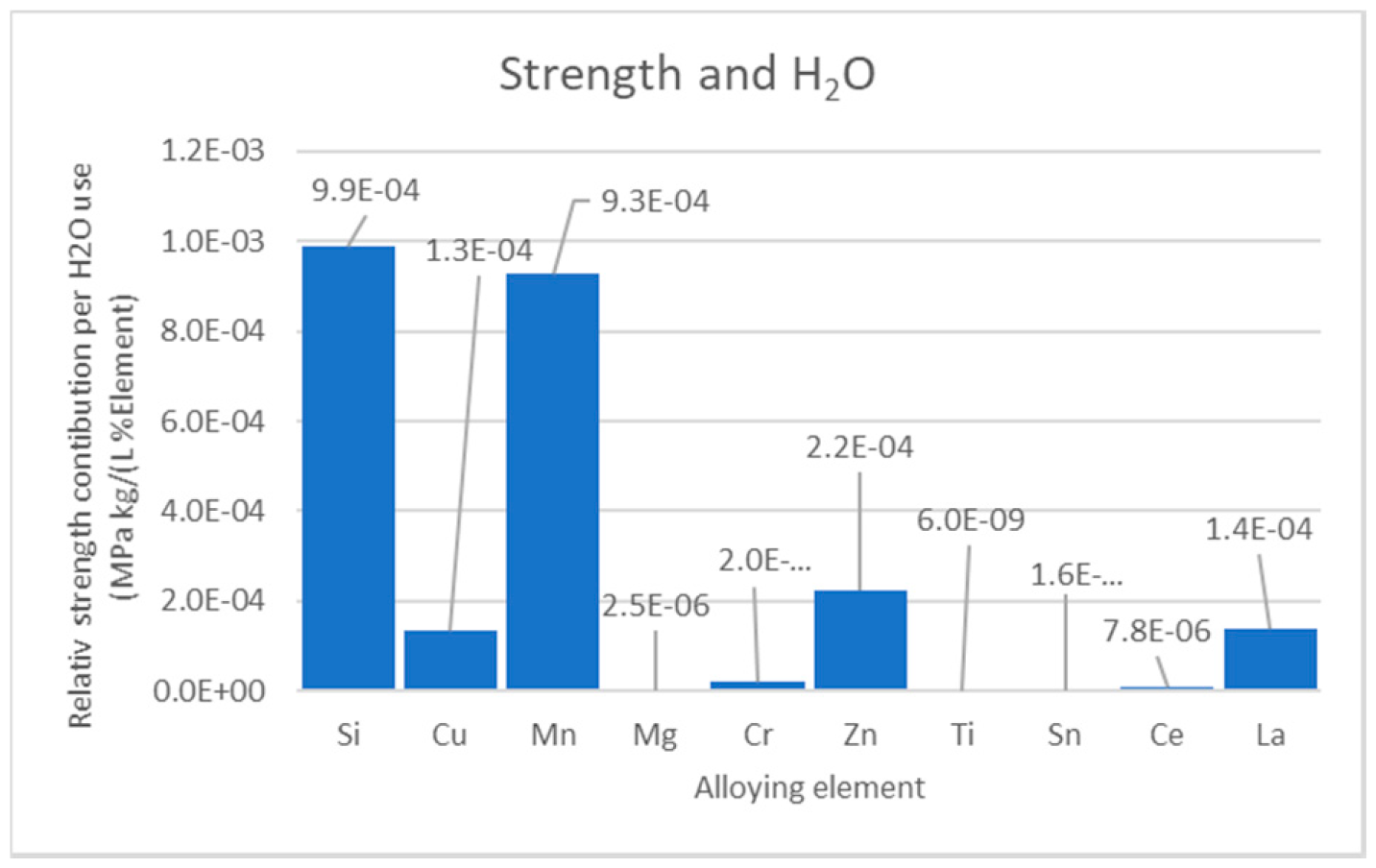
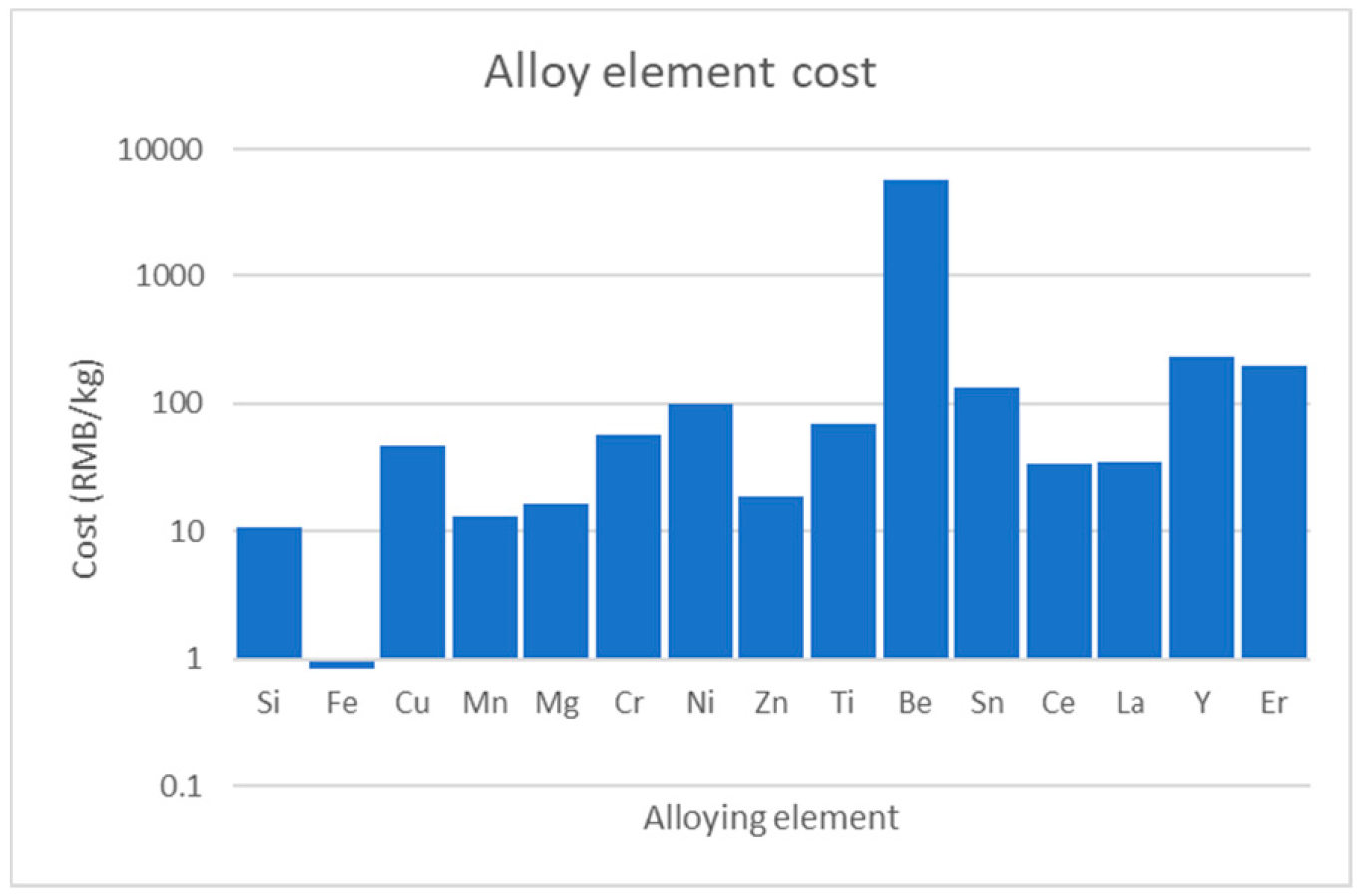

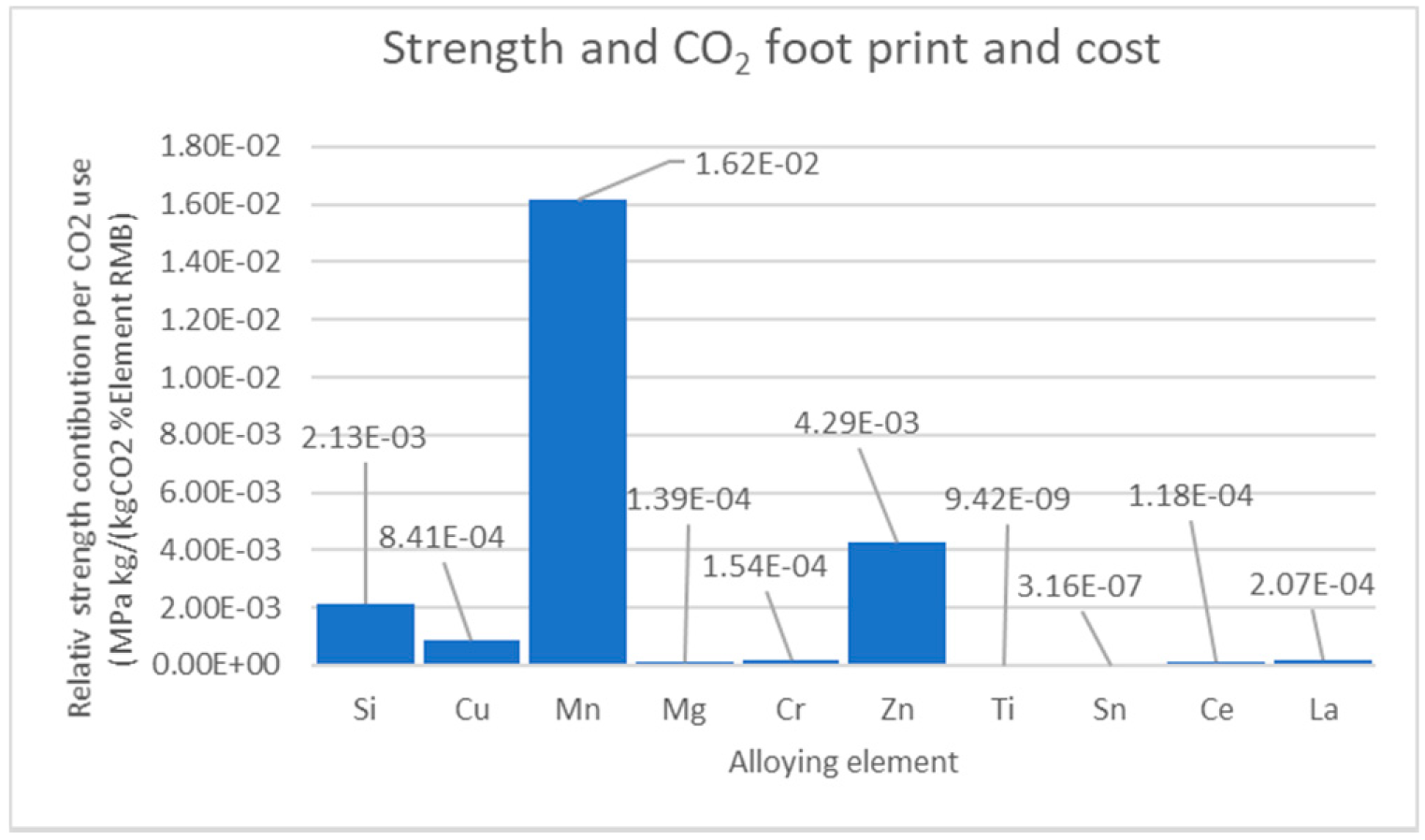
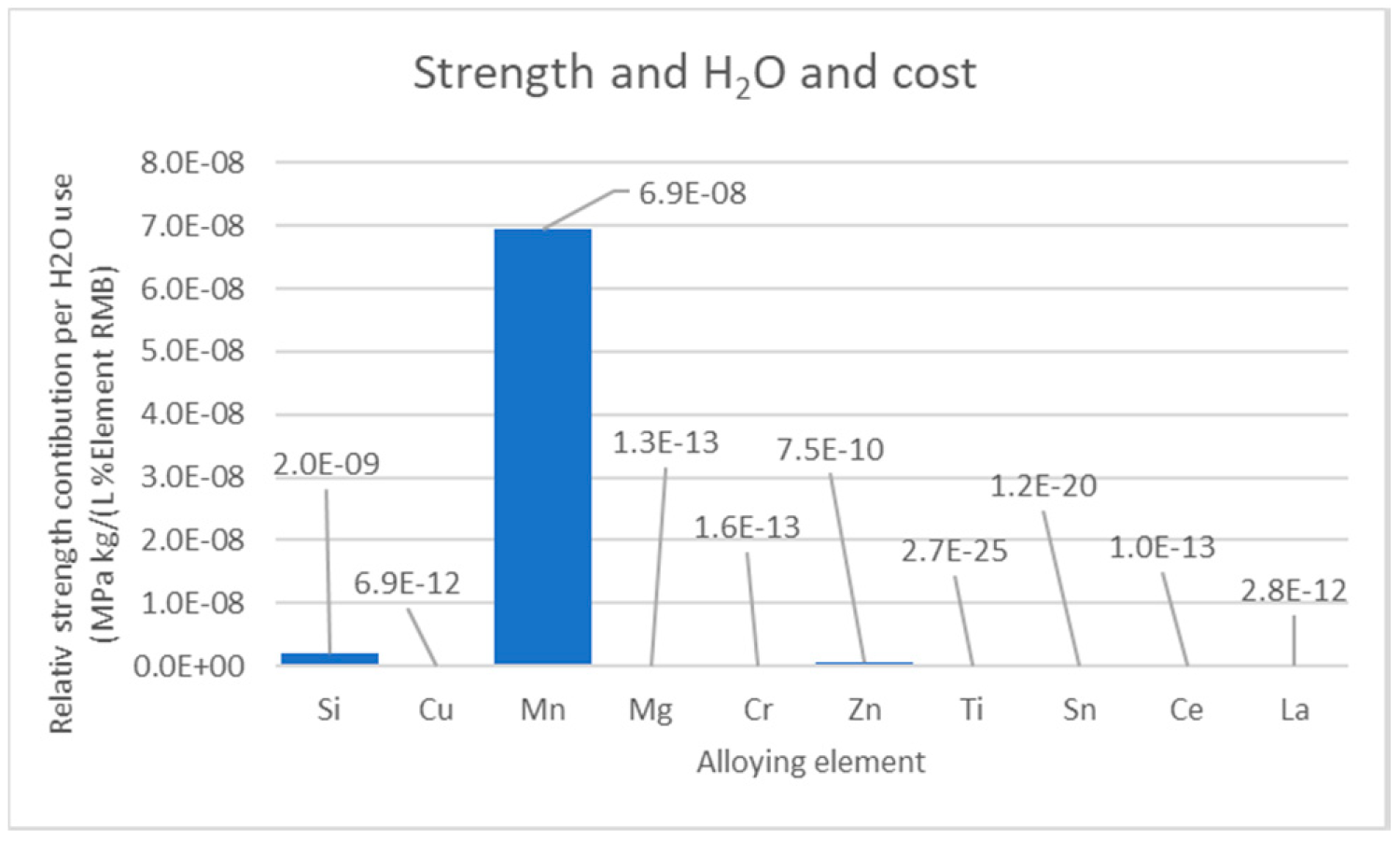
| Element | Al | Si | Fe | Cu | Mn | Mg | Cr | Ni |
| ai (MPa./% element i) | 93.54 | 12.72 | −33.98 | 7.01 | 45.41 | 31.97 | 98.24 | −12.27 |
| Element | Zn | Ti | Be | Sn | Ce | La | Y | Er |
| ai (MPa./% element i) | 12.30 | 0.01 | −0.91 | 6.30 | 64.98 | 31.61 | −47.75 | −54.95 |
| Element | bi Embodied Energy (MJ/kg) Primary Production | ci CO2 Footprint (kg/kg). Primary Production | di Water Usage (L/kg). Pure Element |
|---|---|---|---|
| Si | 116–128 (116) | 4.78–5.27 (4.78) | 23.2–25.7 (23.2) |
| Fe | 23.2–25.6 (23.2) | 2.18–2.4 (2.18) | 44.9–49.6 (44.9) |
| Cu | 56.1–61.9 (51.6) | 3.44–3.79 (3.44) | 297–328 (297) |
| Mn | 55.8–61.5 (55.8) | 3.8–4.19 (3.8) | 231–256 (231) |
| Mg | 310–342 (310) | 44.2–48.7 (44.2) | 930–1030 (930) |
| Cr | 550–606 (550) | 20–22.1 (20) | 451–498 (451) |
| Ni | 159–175 (159) | 11.2–12.3 (11.2) | 79–377 (79) |
| Zn | 44–48.5 (44) | 3.46–3.82 (3.46) | 327–361 (361) |
| Ti | 559–616 (559) | 31.6–34.9 (34.9) | (110) |
| Be | 6080–67,000 (6080) | 821–905 (821) | 340–379 (340) |
| Zr | 1530–1690 (1530) | 98.1–108 (98.1) | 262–289 (262) |
| Ce | 493–544 (493) | 32.4–35.8 (32.4) | 52.4–57.9 (524) |
| La | 258–284 (258) | 16.7–18.4 (16.7) | 52.7–58.2 (52.7) |
| Y | 1400–1540 (1400) | 84.8–93.5 (84.8) | 52.4–57.9 (52.4) |
| Er | 2810–3100 (2810) | 188–207 (188) | 52.7–58.2 (52.7) |
| Element | Rank by E1i | Rank by EM1i | Rank by E2i | Rank by EM2i | Rank by E3i | Rank by EM3i | Impact E1i + E2i + E3i | Impact EM1i + EM2i + EM3i |
|---|---|---|---|---|---|---|---|---|
| Si | 7 | 3 | 4 | 3 | 1 | 2 | 12 (3) | 8 (3) |
| Fe | Negative | Negative | Negative | Negative | Negative | Negative | - | - |
| Cu | 4 | 8 | 3 | 4 | 5 | 4 | 12 (3) | 16 (4) |
| Mn | 1 | 1 | 1 | 1 | 2 | 1 | 4 (1) | 3 (1) |
| Mg | 8 | 4 | 8 | 7 | 8 | 7 | 24 (8) | 19 (6) |
| Cr | 3 | 7 | 5 | 6 | 6 | 6 | 14 (5) | 19 (6) |
| Ni | Negative | Negative | Negative | Negative | Negative | Negative | - | - |
| Zn | 2 | 2 | 2 | 2 | 3 | 3 | 7 (2) | 7 (2) |
| Ti | 10 | 10 | 10 | 10 | 10 | 10 | 30 (10) | 30 (10) |
| Be | Negative | Negative | Negative | Negative | Negative | Negative | - | - |
| Sn | 9 | 9 | 9 | 9 | 9 | 9 | 27 (9) | 27 (9) |
| Ce | 5 | 5 | 7 | 8 | 7 | 8 | 19 (7) | 21(8) |
| La | 6 | 6 | 6 | 5 | 4 | 5 | 16 (6) | 16 (4) |
| Y | Negative | Negative | Negative | Negative | Negative | Negative | - | - |
| Er | Negative | Negative | Negative | Negative | Negative | Negative | - | - |
© 2020 by the authors. Licensee MDPI, Basel, Switzerland. This article is an open access article distributed under the terms and conditions of the Creative Commons Attribution (CC BY) license (http://creativecommons.org/licenses/by/4.0/).
Share and Cite
Jarfors, A.E.W.; Du, A.; Yu, G.; Zheng, J.; Wang, K. On the Sustainable Choice of Alloying Elements for Strength of Aluminum-Based Alloys. Sustainability 2020, 12, 1059. https://doi.org/10.3390/su12031059
Jarfors AEW, Du A, Yu G, Zheng J, Wang K. On the Sustainable Choice of Alloying Elements for Strength of Aluminum-Based Alloys. Sustainability. 2020; 12(3):1059. https://doi.org/10.3390/su12031059
Chicago/Turabian StyleJarfors, Anders E.W., Andong Du, Gegan Yu, Jinchuan Zheng, and Kaikun Wang. 2020. "On the Sustainable Choice of Alloying Elements for Strength of Aluminum-Based Alloys" Sustainability 12, no. 3: 1059. https://doi.org/10.3390/su12031059
APA StyleJarfors, A. E. W., Du, A., Yu, G., Zheng, J., & Wang, K. (2020). On the Sustainable Choice of Alloying Elements for Strength of Aluminum-Based Alloys. Sustainability, 12(3), 1059. https://doi.org/10.3390/su12031059






